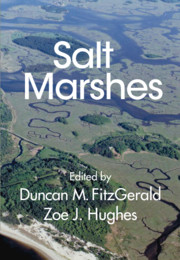Book contents
- Salt Marshes
- Salt Marshes
- Copyright page
- Contents
- Contributors
- Acknowledgments
- 1 State of Salt Marshes
- Part I Marsh Function
- 2 Salt Marsh Distribution, Vegetation, and Evolution
- 3 Salt Marsh Formation
- 4 Salt Marsh Hydrodynamics
- 5 Community Ecology of Salt Marshes
- 6 The Role of Marshes in Coastal Nutrient Dynamics and Loss
- Part II Marsh Dynamics
- Part III Marsh Response to Stress
- Index
- References
2 - Salt Marsh Distribution, Vegetation, and Evolution
from Part I - Marsh Function
Published online by Cambridge University Press: 19 June 2021
- Salt Marshes
- Salt Marshes
- Copyright page
- Contents
- Contributors
- Acknowledgments
- 1 State of Salt Marshes
- Part I Marsh Function
- 2 Salt Marsh Distribution, Vegetation, and Evolution
- 3 Salt Marsh Formation
- 4 Salt Marsh Hydrodynamics
- 5 Community Ecology of Salt Marshes
- 6 The Role of Marshes in Coastal Nutrient Dynamics and Loss
- Part II Marsh Dynamics
- Part III Marsh Response to Stress
- Index
- References
Summary
Salt marshes are common globally in low-lying coastal environments. Their geological settings and ecosystems vary widely by latitude and climatic settings (Chapman, 1960). Allen (2000) provides a comprehensive sketch of European salt marshes, while Rogers and Woodroffe (2014) give a recent summary of the subject. Woodwell et al. (1973) suggest that there are more than 38 million hectares (380,000 km2) of salt marshes worldwide, but specific delineation of distributions is incomplete, particularly in Asia, Africa, and South America. That area is greater than the total area of coastal American states from New Jersey to South Carolina. This chapter concentrates on the east coast of North America as containing examples of well-studied environments, with a few additional examples.
- Type
- Chapter
- Information
- Salt MarshesFunction, Dynamics, and Stresses, pp. 9 - 30Publisher: Cambridge University PressPrint publication year: 2021
References
- 2
- Cited by

